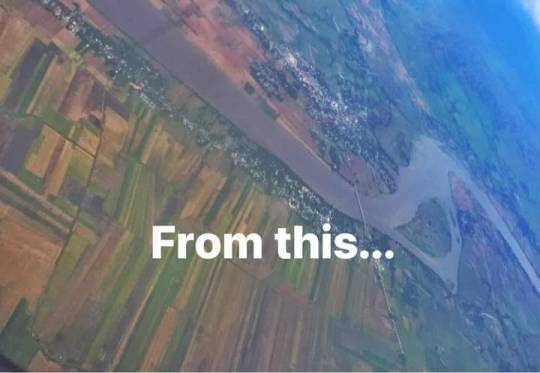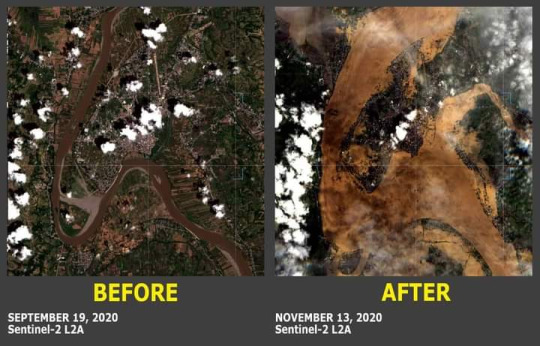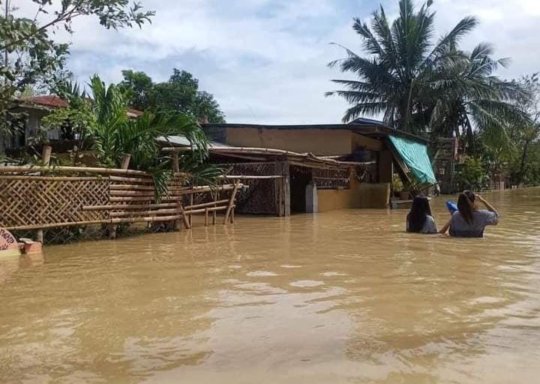#Cyclonic Circulation Update
Explore tagged Tumblr posts
Text
ফুঁসছে সাগর..! পশ্চিমি ঝঞ্ঝা ঘূর্ণাবর্ত..! কাঁপিয়ে বৃষ্টি দক্ষিণবঙ্গের ৪ জেলায়
আগামী ৪৮ ঘণ্টায় বজ্রবিদ্যুৎ-সহ বৃষ্টির সম্ভাবনা বেশি থাকবে পূর্ব মেদিনীপুর উত্তর ও দক্ষিণ ২৪ পরগনা, হাওড়া, কলকাতা, মুর্শিদাবাদ, নদিয়া, বীরভূম, পূর্ব ও পশ্চিম বর্ধমান জেলায়। Source link
View On WordPress
#৪৮ ঘণ্টায় বজ্রবিদ্যুৎ-সহ বৃষ্টি#Cyclonic Circulation Update#IMD Latest Weather#Rainfall Alert#Thunder storm alert in South Bengal IMD predicts heavy rain and gusty wind forecast in these states#West bengal Weather#আবহাওয়ার আপডেট#কলকাতা#জেলা#নদিয়া#নিম্নচাপ সতর্কতা#পূর্ব ও পশ্চিম#পূর্ব মেদিনীপুর উত্তর ও দক্ষিণ ২৪ পরগনা#বর্ধমান#বাংলার আবহাওয়া#বীরভূম#বৃষ্টি#ভারী বৃষ্টির পূর্বাভাস#মুর্শিদাবাদ#হাওড়া
0 notes
Text
Weak Rainfall Anticipated in Jharkhand Over Next Few Days
No severe rainfall alerts have been issued for the state; IMD predicts light to moderate rainfall. Due to a subdued monsoon, Jharkhand anticipates limited rainfall over the next 3-4 days, with a gradual increase in maximum temperatures. RANCHI – The Ranchi Meteorological Centre of IMD anticipates that Jharkhand will experience mild to moderate rainfall over the next five days, with no heavy…
#राज्य#cyclonic circulation Bay of Bengal#IMD rainfall prediction#Jharkhand district rainfall#Jharkhand temperature rise#Jharkhand weather forecast#low-pressure system Bay of Bengal#monsoon trough India#Ranchi Meteorological Centre forecast#state#subdued monsoon Jharkhand#weather update eastern India
0 notes
Text
[ad_1] GG News Bureau Bhubaneswar, 20th Oct. The India Meteorological Department (IMD) has reported the formation of a cyclonic circulation over the central Andaman Sea, which is expected to develop into a low-pressure area by Monday. This weather system could impact coastal regions of North Andhra Pradesh, Odisha, West Bengal, and Bangladesh in the coming week. In a bulletin, the IMD stated, “The cyclonic circulation is formed over the central Andaman Sea. Under its influence, a low-pressure area is likely to form over the Bay of Bengal and adjoining north Andaman Sea around October 21. Thereafter, it is likely to move northwestwards and intensify further into a depression around October 23.” Amidst speculation from international weather models about the possible formation of a cyclone this month, IMD Director General Mrutyunjaya Mohapatra said that a clearer picture would only emerge after the formation of the low-pressure area. “The IMD has made no prediction on whether the system will develop into a cyclonic storm. October is known as the month of cyclones, and some weather models are indicating a probability of cyclogenesis. We provide a forecast on the path and intensification of a system after assessing over 10 weather models, but right now there is no consensus among them as a low-pressure area is yet to be formed,” Mohapatra explained. Potential Impacts and Precautions While it remains uncertain whether the system will develop into a cyclone, Mohapatra highlighted the likelihood of its impact on the coastal areas of North Andhra Pradesh, Odisha, West Bengal, and Bangladesh. He also warned that sea conditions would remain rough along these coasts from October 22 to 25. The IMD has advised fishermen to return to shore by October 21 as a precaution. Heavy rainfall is expected in coastal Odisha between October 23 and 25 due to the influence of the system. In a video message, Mohapatra noted that squally weather with wind speeds of 35-45 kmph, gusting up to 55 kmph, is likely over the east-central and adjoining southeast Bay of Bengal on October 21-22. Weather Forecast for Odisha The IMD forecast for Sunday predicts light to moderate rainfall or thundershowers at isolated locations in southern Odisha and north coastal districts, while dry conditions are expected to prevail in the northern interior regions. Additionally, thunderstorms with lightning are likely in isolated places within Puri, Khurda, Nayagarh, Ganjam, and Gajapati districts on Sunday. The IMD continues to monitor the situation closely and will provide updates as the weather system evolves over the coming days. The post IMD Tracks Cyclonic Circulation Over Andaman Sea appeared first on Global Governance News- Asia's First Bilingual News portal for Global News and Updates. [ad_2] Source link
0 notes
Text
[ad_1] GG News Bureau Bhubaneswar, 20th Oct. The India Meteorological Department (IMD) has reported the formation of a cyclonic circulation over the central Andaman Sea, which is expected to develop into a low-pressure area by Monday. This weather system could impact coastal regions of North Andhra Pradesh, Odisha, West Bengal, and Bangladesh in the coming week. In a bulletin, the IMD stated, “The cyclonic circulation is formed over the central Andaman Sea. Under its influence, a low-pressure area is likely to form over the Bay of Bengal and adjoining north Andaman Sea around October 21. Thereafter, it is likely to move northwestwards and intensify further into a depression around October 23.” Amidst speculation from international weather models about the possible formation of a cyclone this month, IMD Director General Mrutyunjaya Mohapatra said that a clearer picture would only emerge after the formation of the low-pressure area. “The IMD has made no prediction on whether the system will develop into a cyclonic storm. October is known as the month of cyclones, and some weather models are indicating a probability of cyclogenesis. We provide a forecast on the path and intensification of a system after assessing over 10 weather models, but right now there is no consensus among them as a low-pressure area is yet to be formed,” Mohapatra explained. Potential Impacts and Precautions While it remains uncertain whether the system will develop into a cyclone, Mohapatra highlighted the likelihood of its impact on the coastal areas of North Andhra Pradesh, Odisha, West Bengal, and Bangladesh. He also warned that sea conditions would remain rough along these coasts from October 22 to 25. The IMD has advised fishermen to return to shore by October 21 as a precaution. Heavy rainfall is expected in coastal Odisha between October 23 and 25 due to the influence of the system. In a video message, Mohapatra noted that squally weather with wind speeds of 35-45 kmph, gusting up to 55 kmph, is likely over the east-central and adjoining southeast Bay of Bengal on October 21-22. Weather Forecast for Odisha The IMD forecast for Sunday predicts light to moderate rainfall or thundershowers at isolated locations in southern Odisha and north coastal districts, while dry conditions are expected to prevail in the northern interior regions. Additionally, thunderstorms with lightning are likely in isolated places within Puri, Khurda, Nayagarh, Ganjam, and Gajapati districts on Sunday. The IMD continues to monitor the situation closely and will provide updates as the weather system evolves over the coming days. The post IMD Tracks Cyclonic Circulation Over Andaman Sea appeared first on Global Governance News- Asia's First Bilingual News portal for Global News and Updates. [ad_2] Source link
0 notes
Text
Maharashtra Weather Update: Heavy Rains Expected Across the State This Week, Yellow Alert Issued for Several Districts
The Pune Meteorological Department reported the development of a cyclonic circulation over South Myanmar and the Bay of Bengal, leading to the formation of a low-pressure area in the Bay of Bengal. The intensity of this system has increased, and it is moving towards Maharashtra, triggering the possibility of rainfall over the next few days. Conditions are becoming favorable for the withdrawal of…
0 notes
Text
Exploring the Jet Stream UPSC: A Comprehensive Overview

The UPSC syllabus, particularly in GS Paper I (Geography) and GS Paper III (Environment & Disaster Management), emphasizes understanding atmospheric phenomena impacting weather patterns. Among these, the Jet Stream UPSC plays a crucial role in shaping global weather systems. This article delves into the complexities of the Jet Stream, a crucial concept for UPSC aspirants.
What is the Jet Stream?
The Jet Stream is a narrow band of fast-moving air currents located high in the troposphere (the lowest layer of the atmosphere). These winds travel at speeds exceeding 200 km/h (125 mph) and are concentrated in westerly directions (west to east). The temperature difference between the equator and the poles creates these high-speed winds. Warm air rises near the equator, creating a pressure difference that drives air currents towards the poles. As this air travels, it cools and descends, eventually returning towards the equator. This global circulation pattern, known as the Hadley Cell, creates the Jet Stream UPSC at the upper levels of the troposphere.
Types of Jet Streams:
There are two primary types of Jet Streams:
Polar Jet Stream: The most prominent jet stream, located at around 10-12 km above the Earth's surface, primarily in the Northern and Southern Hemispheres. This jet stream significantly influences mid-latitude weather patterns.
Subtropical Jet Stream: Located at higher altitudes (around 16-18 km) and weaker than the polar jet stream. It can have a significant impact on tropical weather systems.
Impact of Jet Stream on Weather Systems:
The Jet Stream plays a critical role in various weather phenomena:
Mid-Latitude Weather Systems: The meandering nature of the jet stream creates high and low-pressure zones that drive the formation of mid-latitude cyclones and anticyclones. These weather systems influence wind patterns, precipitation, and temperature variations across the globe.
Storm Tracks: The jet stream UPSC steers the movement of storm systems, impacting where they form, intensify, and weaken. Understanding the jet stream helps predict the movement of storms and potential weather events.
Temperature Variations: The jet stream can act as a barrier, separating warm and cold air masses. A stronger jet stream can lead to more extreme temperature variations between polar and tropical regions.
Jet Stream and Climate Change:
Climate change is altering global atmospheric circulation patterns, potentially impacting the behavior of the jet stream. Some studies suggest that a warming climate could lead to a wavier jet stream, resulting in more extreme weather events like heatwaves, droughts, and floods in certain regions.
Importance of Jet Stream for UPSC:
Understanding the Jet Stream for UPSC aspirants is crucial due to its influence on various aspects covered in the syllabus:
Climate Change: The impact of climate change on the jet stream and its link to extreme weather events is a critical area of UPSC focus.
Weather Patterns: Knowledge of the jet stream helps understand the formation and movement of weather systems, impacting regional climate and agriculture.
Disaster Management: Predicting the trajectory of storms and other weather events relies heavily on understanding the behavior of the jet stream.
Conclusion:
The Jet Stream UPSC is a powerful force shaping weather patterns across the globe. Understanding its behavior and how it interacts with climate change is essential for UPSC aspirants aiming to excel in Geography, Environment, and Disaster Management. As research on the jet stream's response to climate change continues, staying updated on this crucial aspect of weather systems will be increasingly important.
Take that first step toward your dream career. Contact Tarun IAS today and let us help you achieve UPSC success!
0 notes
Link
Stay updated on the weather forecast for April 30, 2024, across India. Learn about cyclonic circulations, rainfall distributions
0 notes
Text
Gujarat: 20 dead in lightning strikes amid unseasonal rainfall
PTI reports a tragic toll of twenty lives lost in Gujarat due to lightning strikes during unseasonal rainfall across various districts. Dahod, Bharuch, Tapi, Ahmedabad, Amreli, Banaskantha, Botad, Kheda, Mehsana, Panchmahal, Sabarkantha, Surat, Surendranagar, and Devbhumi Dwarka were affected, as confirmed by the State Emergency Operation Centre (SEOC).

Yesterday's storms claimed eight lives, including a biker in Botad and a man in Mehsana hit by a falling tree. Two farmers in Tapi and one in Sabarkantha, Ahmedabad, Mehsana, and Dahod also succumbed to lightning strikes amid the heavy rain.
Reportedly, 220 of 251 talukas in Gujarat received substantial rainfall, with Ahmedabad city experiencing 15 mm. The Indian Meteorological Department (IMD) attributed this unusual weather to a cyclonic circulation over the northeast Arabian Sea and nearby Saurashtra-Kutch regions.
IMD forecasts a decrease in rain activity by Monday, concentrating in select areas of south Gujarat and Saurashtra. Additionally, rainfall alerts have been issued for parts of Maharashtra, Rajasthan, and southwest Madhya Pradesh. IMD anticipates light to moderate rain in isolated areas of Punjab, Haryana, West Uttar Pradesh, Jammu and Kashmir, and Himachal Pradesh.
In a late-night update on 'X,' IMD alerted about impending rainfall with thunderstorms, gusty winds, and hailstorms in regions colored orange and red (south Rajasthan, Maharashtra, southwest Madhya Pradesh) within the next 2-3 hours. Regular updates are underway to track the situation.
0 notes
Text

Southwestern Gulf of Mexico (AL93): Updated: Showers and thunderstorms remain disorganized this afternoon in association with a broad area of low pressure located over the southwestern Gulf of Mexico. Data from an Air Force Reserve Reconnaissance aircraft investigating the system has so far found the circulation remains elongated and not well-defined, with maximum sustained winds of only 20-25 mph. Based on the current structure, additional development is becoming unlikely before the system merges with a developing frontal boundary over the western Gulf of Mexico on Wednesday. 2. Regardless of tropical cyclone development, the system is forecast to produce gale-force winds over portions of the northern Gulf of Mexico by tomorrow, and potentially heavy rainfall along the Gulf Coast by the latter portion of this week. For more information, see products from your local National Weather Service office, and high seas forecasts issued by the National Weather Service. * Formation chance through 48 hours...low...10 percent. * Formation chance through 7 days...low...10 percent.
0 notes
Text
IMD Issues fresh rainfall warning. Uttarakhand and Himachal Pradesh are on orange alert
The Indian Meteorological Department has predicted heavy rainfall in parts of North and Central India in the next five days. As per the notification, the west coast will receive enhanced rainfall while the three would be heavy rainfall over parts of northwest India, including Himachal Pradesh and Uttarakhand for the next 2 days.
The IMD has also issued heavy rainfall alerts for Uttarakhand and Himachal Pradesh where heavy rainfall chances are at peak on 16th and 17 July. The two states are under orange alert.
On Sunday, Vikram Singh, Director, Meteorological Department, Dehradun said, “There is a possibility of more rainfall in Uttarakhand on July 16 and 17. For today, a red alert has been issued in Dehradun, Tehri, Pauri, and Haridwar districts and an orange alert has been issued for the remaining districts. There will be a slight reduction in rainfall on July 18."
The IMD said that states including Himachal Pradesh, Uttarakhand, and East Uttar Pradesh as well as Chandigarh will have heavy rainfall today whereas states including West Uttar Pradesh and East Rajasthan will have heavy rainfall for the next four days.
On Sunday, M Mohapatra, director general at the weather office said, “For the next week, we can expect active monsoon over central India. A low-pressure area has developed while another cyclonic circulation will develop around Tuesday. These will lead to good rainfall and may cover the rain deficiency over central and peninsular regions.”
“The western disturbance will also continue to bring rain to north India,” he added.
For more weather updates India in Hindi, subscribe to our newsletter.
#werindia#leading india news source#top news stories#latest national news#national news#top news of the day#heavy rainfall#weather alert#weather update#top news headlines
0 notes
Photo

At 07:00hr CDT (12:00 UTC), the center of Tropical Storm Beatriz was about 75 km SSE of Cabo Corrientes and 145 km NW of Manzanillo, Mexico. Beatriz is moving toward the northwest near 20 km/h (13mph), and this general motion with a gradual decrease in forward speed is expected through tonight. On the forecast track, the center of Beatriz is expected to move near or over portions of the coast of southwestern Mexico through this morning.
Interests elsewhere along the west-central coast of Mexico and in the southern portion of the Baja California peninsula should monitor the progress of this system.
The center of Beatriz brushed the coast of Mexico near Punta San Telmo back around 00{00 UTC, and since then the cyclone has steadily lost organization. Earlier microwave satellite imagery shows that the eye has disappeared, while scatterometer and synthetic aperture radar data suggest that the surface circulation has become less well defined. In addition, surface observations in and around Manzanillo have not been supportive of a well-defined circulation in the area. Based on these observations and an accompanying decrease in the satellite cloud pattern, the initial intensity is reduced to an uncertain 55 kt.
Although Beatriz will be moving away from the coast of Mexico later today, the dynamical models suggest that the cyclone will not recover from the effects of land interaction, with most of them forecasting the system to dissipate to 2-3 days time or less. The new NHC intensity forecast is notably lower than the previous forecast and calls for the system to weaken to a depression by 60 h and dissipate soon thereafter. There is a chance that Beatriz could weaken faster than currently forecast.
Join the Baja Weather Channel for instant updates here....
1 note
·
View note
Text
Jharkhand Braces for Heavy Rainfall as Low-Pressure System Looms
IMD Issues 72-Hour Weather Alert for Isolated Areas Across the State Monsoon trough and cyclonic circulation over Bangladesh to trigger intense precipitation in Jharkhand, meteorologists predict. RANCHI – The Ranchi center of the Indian Meteorological Department has issued a warning regarding the potential for torrential rainfall in isolated regions of Jharkhand within the next three days. In the…
#राज्य#cyclonic circulation Bangladesh#flood preparedness Jharkhand#IMD weather alert#isolated heavy rain forecast#Jharkhand Heavy Rainfall#Jharkhand monsoon update#low-pressure system impact#monsoon trough effects#regional weather patterns#state#weather disruption eastern India
0 notes
Text
Help the Philippines
Several strong typhoons battered the Philippines, especially Luzon, and caused billions of casualties through the typhoons Quinta (international name, Molave), Rolly (international name, Goni), and Ulysses (international name, Vamco). I know my account isn’t that big but I hope I could help spread awareness about my country’s situation in any platform I have.
#QuintaPH
A total of 242,220 residents or 57,742 families from 1,008 barangays in Central Luzon, Calabarzon, Mimaropa, Western and Eastern Visayas were affected by Typhoon Quinta. Of the total affected, 65,579 persons or 16,830 families sought refuge in evacuation centers. Cost of damage to agriculture and infrastructure has also risen to ₱737.1 million, with Calabarzon bearing the highest cost worth ₱593.1 million. Typhoon Quinta partially destroyed 27,213 houses while 2,315 others were totally damaged. At least 330 passengers remain stranded in the different ports of Calabarzon, Mimaropa, Bicol Region, Western and Eastern Visayas. (source: CNN)
#RollyPH
Rolly, at its peak, made 2 landfalls in Bicol region (Catanduanes and Bicol), prompting some 96,887 families or 372,381 persons to evacuate their homes. Some 147 houses were submerged in lahar and debris from Mt. Mayon. The country's 18th storm this year left an estimated P694.37 million worth of damage to agriculture in Bicol alone, according to the report citing the Department of Agriculture. (source: ABS-CBN News)
#UlyssesPH
Typhoon Ulysses, the Philippines' 21st tropical cyclone for 2020, began pummeling Luzon on November 11. Still reeling from Super Typhoon Rolly (Goni), Bicol was the first to face Ulysses' wrath, as the typhoon triggered massive floods in parts of the region. Ulysses then battered Calabarzon, Central Luzon, and Metro Manila, unleashing powerful winds and torrential rain that left neighborhoods submerged and people appealing for aid and rescue. (Source: Rappler)
150,000 farmers and 275,000 hectares of land have incurred losses amounting up to P10-B (~268 USD) after the devastations caused by Typhoons Quinta, Rolly, and Ulysses. That’s from agriculture alone, the losses from the massive flooding of Cagayan and Isabela are still not included in the computation. (source: CNN)
Massive flooding in Cagayan, due to continuous environment abuse
The massive flooding in Cagayan, the worse yet in 40 years, only shows environmental neglect. The biggest problem is the degradation of forests in both Cagayan and Sierra Madre sides. Today, the Cagayan River isn’t even visible as the region submerges in flood.


The province is the catch basin of rain water coming from Cagayan Valley and the Cordillera Administrative Region. Illegal logging has veeb a problem as well for the past 5 decades. The flooding has affected at least 179, 940 individuals in 26 municipalities of Cagayan. More than 11,000 families have been evacuated.

Several factors caused the floods, including recent tropical cyclones and tail-end of a cold front, which prompted the release of water from Magat Dam. Excess water flowed to Cagayan River and its tributaries, flooding communities. (source: Rappler)
Dam operators must be held accountable for Cagayan and Isabela floods
The widespread flooding in Cagayan that gripped the nation this weekend is partly being blamed on the massive release of water from Magat Dam. Typhoon Ulysses made landfall late night Wednesday, November 11, and by Thursday, November 12, Magat Dam opened 7 gates and discharged 6,244 cubic meters of water per second. Dams including Magat rushed to open gates only at the height of Ulysses.
Magat did not make sufficient water drawdown 2 to 3 days prior to Ulysses, as mandated by its protocol, because its gates were not even open 3 to 4 days prior to landfall According to the Magat Dam protocol, there should be a drawdown 2-3 days before the expected landfall.
They had 3 days in advance [to pre-release water], the forecast was made at least 3 days in advance. If you did not contain the release within 1-2 days only but rather within 5 days, then the rivers will be able to handle it better.
The panic on Friday night was partly due to a dearth of information coming from inside Cagayan, which national media had not physically reached at that time. The steady stream of updates only came from the Twitter feed of Vice President Leni Robredo, who herself was also only getting updates from Manila. (source: Rappler)
Save Sierra Madre, Stop Kaliwa Dam
Sierra Madre is the longest mountain range in the Philippines and it protects the country from strong typhoons. However, illegal and abusive deforestation is keeping it from maintaining its full functionality. Kaliwa Dam is proposed to be built along Sierra Madre mountain range, and the environment experts and the citizens are wary of its possible repercussions.




You can help us stop the creation of Kaliwa Dam by signing the following petitions:
Link 1
Link 2
Pampanga Needs Help
Just like what’s happening in Cagayan and Isabela, Pampanga is also facing the run-offs by massive floods from Sierra Madre, Tarlac, and Nueva Ecija. Water from Bulacan will go down to Macabebe and Masantol. Waters in San Luis, Pampanga already reached head level.


Citizen-blaming
Office of Civil Defense Asec. Casiano Monilla denies that government was caught flat-footed by Ulysses and shifts blame to citizens who supposedly did not heed early warnings. The prime duty of the government is to serve and protect its people. The government refuses to be held accountable from their own incompetence. There wasn’t even a proper briefing before the typhoon struck.
Sen. Gordon also told the public that “No one will take care of you or your family best other than you. Don’t rely on the government.” This also caused unrest in the citizens who wanted to ensure the safety of one another. Because it only seems that we always have to beg to be served when in fact, all the money circulating the government came from taxpayers’ hardworks .
Oust Duterte, Now
Amidst all struggles the Filipino people are facing right now, from the covid virus up to the cyclone casualties, all of it comes down with the toxic and overly romanticized Filipino Resilience. Additional disaster response are not even planned well, hence the lack of mobilization. The president has all the power to do so, with one word. But not only does he keep the people waiting during crisis, he also only does briefing during or after the disasters. This is why people ask, “Nasaan ang Pangulo?” (Where is the President?)
Fanatics defended the president from criticisms, when asking for his presence will always be a valid question, because we all want to see the response to those who need it most, and not some measly comment on how he wanted to swim with the Filipinos but can’t, because of his health. That is not the point. The president doesn’t need to swim in order to reach help to the Filipinos, he just has to tell all of the country’s rescue forces to hurry.
Addressing the Taal Volcano eruption — “I will eat the lahar and pee on the volcano.”
Addressing the Covid virus — “I will spit [on] and punch the coronavirus.”
Addressing the massive flooding and demand for accountability — “I want to swim with you but the problem is, they’re stopping me, because if I die, there is only one president.”
The Filipinos can no longer wait and laugh at measly hyperbole. People are dying.
Monetary support
Thankfully, independent rescue missions and donations were arranged by several individuals and organizations to lend a hand to those in need. One of those who were seen with initiatives is the Office of the Vice President who is in partnership with Bangon Luzon in Project Kaya Natin ‘To (We can do this). So if you’re looking for a trustworthy organization to donate for the victims of the typhoons, this is where you should donate.

You can also check these carrds for more information about what the Filipinos are fighting for:
Help the Philippines
For the Philippines
SOGIE Bill
If you have read until this far, thank you so much for being concerned. It will also be nice to have this post reblogged so that we can spread this further. Stay safe and have a nice day.
8 notes
·
View notes
Text
West Coast Wildfire Smoke Reported as Far East as the Netherlands
https://sciencespies.com/news/west-coast-wildfire-smoke-reported-as-far-east-as-the-netherlands/
West Coast Wildfire Smoke Reported as Far East as the Netherlands
Smoke from the devastating wildfires in California, Oregon and Washington turned blue skies to a washed-out white across the United States this week. Many cities, including New York, Chicago and Washington, D.C., witnessed a few days of hazy skies and vibrant sunsets.
The smoke travelled eastward along a jet stream, a strong air current that circulates high above the ground, according to NASA. Smoke was even reported as far east as the Netherlands. Along with the smoke, small particles and chemicals called aerosols, which cause hazardous air quality, also moved east.
“Satellite images this morning show smoke aloft moving over much of the Northeast and Mid-Atlantic,” the National Weather Service’s Baltimore-Washington office tweeted Tuesday morning. “This smoke is obscuring the sun, and will keep temperatures a few degrees cooler today than what would be observed if the smoke was not present.”
Notice that hazy, milky sky this morning? That is a result of smoke (well above our heads) from wildfires across the Western US. Notice that the smoke originates across the west and then gets pulled to the east due to the jet stream aloft. The haziness may increase later today. pic.twitter.com/wBOQHfpcmM
— NWS Wakefield (@NWSWakefieldVA) September 15, 2020
Additionally, a westward cyclone sucked in clouds of smoke as it swirled over the Pacific Ocean this week. The storm and smoke have now travelled more than 1,300 miles over the ocean, creating a thick cloud visible from space, reports Anna Buchmann for the San Francisco Chronicle.
The massive fires continue to ravage the West Coast. As of September 13, more than 4 million acres have burned and at least 35 people killed by the fires. As forests and towns in Oregon, California, Washington and Idaho rapidly burn, plumes of ash fill the air.
The air quality in this region is now the worst in the world, topping the most polluted cities globally. In Oregon, particulates of ash and smoke have reached record levels in Portland, Eugene, Bend, Medford and Klamath Falls, reports the Guardian. In Bend, the air quality index measured more than 500, exceeding the upper limit of the scale.
UPDATE: In this 24-hr #GeoColor loop, @NOAA‘s #GOES17
Wildfire smoke contains dangerous pollutants like ozone, carbon monoxide, polycyclic aromatic compounds and nitrogen dioxide, which can contribute to respiratory and cardiovascular diseases, reports Sarah Gibbens and Amy McKeever for National Geographic. When exposed to wildfire smoke for a temporary period, a healthy person may feel a sting in their eyes and trouble recovering their breath, but it remains unclear what the health effects of prolonged, yearly exposure might be.
“Wildfire smoke can affect the health almost immediately,” Jiayun Angela Yao, an environmental health researcher in Canada tells Erin McCormick for the Guardian.
In a study Yao co-authored, her team found that the number of ambulance dispatches related to asthma, lung disease and cardiac events increased by 10 percent within one hour fire smoke taking over Vancouver.
Forecasters predict that Oregon may experience rain in coming days as a lower-pressure system moves in from the Pacific Ocean, Rebecca Muessle, a National Weather Service meteorologist tells Luke Money and Richard Read for the Los Angeles Times. The precipitation may actually cause larger smoke plumes, much like dousing a campfire.
The smoke clouds that have travelled to central and eastern North America mostly remain high in the atmosphere, which makes the sky appear hazy but does not greatly impact the air quality on the ground. New York Metro Weather expects the smoke to clear in the east by the end of the week.
Like this article? SIGN UP for our newsletter
#News
1 note
·
View note
Quote
The anti-cyclonic Beaufort Gyre is the dominant circulation of the Canada Basin and the largest freshwater reservoir in the Arctic Ocean. During the first part of the 2000s, the gyre intensified, expanded and accumulated freshwater. Using an extensive hydrographic dataset from 2003 to 2019, together with updated satellite dynamic ocean topography data, we find that over the past decade the Beaufort Gyre has transitioned to a quasi-stable state in which the increase in sea surface height of the gyre has slowed and the freshwater content has plateaued. In addition, the cold halocline layer, which isolates the warm/salty Atlantic water at depth, has thinned significantly due to less input of cold and salty water stemming from the Pacific Ocean and the Chukchi Sea shelf, together with greater entrainment of lighter water from the eastern Beaufort Sea. This recent transition of the Beaufort Gyre is associated with a southeastward shift in its location as a result of variation in the regional wind forcing. Our results imply that continued thinning of the cold halocline layer could modulate the present stable state, allowing for a freshwater release. This, in turn, could freshen the subpolar North Atlantic, impacting the Atlantic Meridional Overturning Circulation.
Recent state transition of the Arctic Ocean’s Beaufort Gyre | Nature Geoscience
0 notes
Text
Cyclone Mocha: IMD predicts an upcoming cyclonic storm over the Bay of Bengal

As a low-pressure area develops in the region, Cyclone Mocha, the year's first cyclone, is expected to form over the southeast Bay of Bengal this week. A cyclonic circulation is expected to form around May 6, according to the IMD. However, the cyclone's formation has yet to be confirmed. "On or around May 6, 2023, a cyclonic circulation is likely to form over the southeast Bay of Bengal." "A low-pressure area is likely to form over the same region during the next 48 hours (May 7 and 8) under its influence," the IMD stated on Tuesday. https://twitter.com/Indiametdept/status/1653319468192497664?s=20 The IMD issued its statement after the Global Forecast System, the US weather forecast model, and the European Centre for Medium-Range Weather Forecasts predicted the formation of a cyclonic storm over the Bay of Bengal. The cyclonic storm, if it forms, will be named 'Cyclone Mocha' according to the WMO/ESCAP nomenclature system. Yemen suggested the name, which is based on the Red Sea port city. Most cyclones that formed in the region in recent years, including Amphan in 2020, Asani in 2021, and Yaas in 2022, made landfall in May. Though the IMD has made no predictions about Cyclone Mocha's path, its impact on the coasts of West Bengal and Odisha cannot be ruled out. The Odisha government has already begun preparations to mitigate any damage caused by the cyclone. According to Windy.com, the cyclonic storm is expected to pass over the Bay of Bengal on Tuesday next week. It will then gradually move northward, closer to the Indian coast. A low-pressure area forming over the southeast region of the Bay of Bengal will intensify into a cyclonic storm on May 9 near the Andaman Islands, according to the IMD-Global Forecast System (GFS). According to the IMD's forecast, the storm will move north-northeastward towards the east-central Bay of Bengal until May 11. On May 11, a low-pressure area will form in the south Andaman Sea and the southeast Bay of Bengal, followed by a cyclonic storm, according to the European Centre for Medium-Range Weather Forecast (ECMWF). Tags: cyclone mocha update, cyclone mocha 2023, mocha cyclone chennai, new Cyclone, Cyclone Mocha, Cyclone Bay of Bengal, Cyclone in May, Cyclone landfall, Cyclone Mocha Odisha, Odisha Cyclone Read the full article
0 notes